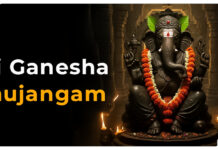
The Divine Abode of Vaishno Devi
Nestled in the majestic Trikuta Mountains, the ancient cave temple of Vaishno Devi is a living testament to India’s rich spiritual heritage. Dedicated to Goddess Vaishno Devi, an embodiment of Mahakali, Mahalakshmi, and Mahasaraswati, this sacred shrine holds a special place in the hearts of millions of devotees who visit each year, seeking blessings and divine guidance.
The Story of Vaishno Devi
The story of Vaishno Devi is ancient and deeply spiritual. Long ago, during the Treta Yuga, the goddesses Parvati, Saraswati, and Lakshmi came together and took birth as a princess named Vaishno Devi. Her purpose was to help and protect humanity. Vaishno Devi spent many years meditating in a cave in the Trikuta Mountains, where her spiritual energy grew stronger. Eventually, she transformed into her divine form, combining the powers of the three goddesses, and made the cave her eternal home.
Where Is Vaishno Devi Temple?
The temple is located near Katra, a small town in Jammu and Kashmir, at a height of 5,300 feet in the Trikuta Mountains. Surrounded by breathtaking scenery, the temple is not just a spiritual destination but also a place of natural beauty.
How Vaishno Devi Was Born
According to another legend, in South India, a couple named Ratnakar and his wife prayed to Goddess Durga for a child. Answering their prayers, the Goddess was born as their daughter, Vaishnavi, who grew up to be a divine embodiment of Lakshmi, Saraswati, and Parvati.
Vaishnavi’s Journey of Meditation
As a child, Vaishnavi showed extraordinary devotion to Lord Rama. At the age of nine, she left her home to meditate in the forest. She wished to marry Lord Rama, but he gently told her that he had taken a vow of having only one wife. However, he promised her that in his next incarnation as Kalki during the Kaliyuga, he would fulfill her wish.
The Struggles of Vaishnavi
As Vaishnavi’s fame grew, a local sage named Ghoraknath became jealous and sent his disciple Bhairavnath to disturb her. Bhairavnath was fascinated by her divine beauty and insisted on marrying her. When she refused, he tried to disrupt her meditation.
To escape his harassment, Vaishnavi moved to a cave and prayed to Hanuman for protection. Bhairavnath continued to pursue her, leading to a struggle that lasted nine months.
The Defeat of Bhairavnath
Finally, Vaishno Devi transformed into her fierce form as Kali and beheaded Bhairavnath. Before dying, Bhairavnath begged for forgiveness. Moved by his repentance, Vaishno Devi granted him a boon that no pilgrimage to her shrine would be complete without visiting Bhairavnath’s temple, symbolizing forgiveness and redemption.
The Holy Cave and Self-Manifestation
After defeating Bhairavnath, Vaishno Devi took the form of a sacred rock inside the cave, where her divine energy is still worshipped today. This temple is considered one of the most sacred places in India, believed to hold the combined powers of Mahakali, Mahalakshmi, and Mahasaraswati.
Vaishno Devi in Indian Epics
Vaishno Devi’s importance is also mentioned in Indian epics like the Mahabharata. It is believed that before the great war of Kurukshetra, Lord Krishna advised Arjuna to pray to Goddess Durga. This highlights her role as a powerful and protective deity.
A Journey Through Time
Vaishno Devi temple has been a place of worship for centuries. It is said that the Pandavas, the heroes of the Mahabharata, were the first to build a shrine here. Even today, there are five stone structures near the temple that are believed to represent the five Pandavas.
The Pilgrimage
The journey to Vaishno Devi is believed to be a spiritual blessing. Situated near Katra, the temple is accessible by a 12-kilometer trek, which can be done on foot, on horseback, or via helicopter services. Despite the effort, millions of pilgrims make this journey each year, believing it cleanses their sins and brings peace and prosperity.
Travel Tips
- The nearest airport is in Jammu, about 42 kilometers from Katra.
- From Katra, the trek to the temple begins.
- Mobile phones, cameras, and leather items (like belts or purses) are not allowed inside the temple.
- Food and water are available along the trekking route.
Related Posts:
Mahakali Jayanti 2025 in English | Rituals, Puja Vidh & Story About Mahakali Avatar
Kurma Dwadashi | Significance & Traditions of Kurma Dwadashi










